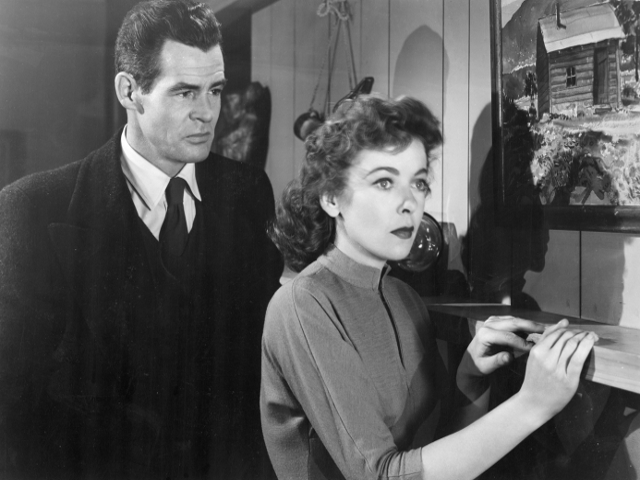Craig (from Dark Eye Socket) here with Take Three. This week actress and director Ida Lupino
 Ida Lupino a "sensation" circa 1941
Ida Lupino a "sensation" circa 1941
Take One: The Bigamist (1953)
The Bigamist probes unseemly marital behaviour and stews on moral sorrows. At its centre is Edmond O’Brien toing and froing between two wives. But behind the camera as director, and in a supporting role as O’Brien’s second, San Francisco wife Phyllis Martin, is Ida Lupino. Her unfussy direction creates lean drama and her performance beautifully matches it, with nary an unnecessary furtive glance or superfluous line spoken. She’s a woman bored on a bus tour of Hollywood stars’ homes, chatted up by O’Brien’s depressed bigamist Harry Graham. 
Edmond as Harry: Haven’t you any interest in how the other half lives?
Ida as Phyllis: No, not particularly. I’m just crazy about bus rides – gives me a chance to get off my feet.”
Phyllis is smart, practical and wryly humorous. She’s world-weary enough to spot a chancer, but curious enough to give him his chance. Yet, she’s not someone to be taken advantage of. She’s part good-time gal, hired by a failing Chinese restaurant to perk up business that she herself acknowledges she’s failed to do, and part susceptible single girl. It’s clear she wants companionship, so she involves herself unknowingly in an already-married man’s emotions. Lupino deftly conveys just the right levels of guarded vulnerability and earthy pluckiness.
Lupino directed herself twice on screen prior to The Bigamist in Outrage (1950) and Hard, Fast and Beautiful (1951) – but only in unnamed, uncredited cameos. Here she creates for herself a memorable emotionally driven character which she nails with snap and skill. With the cheeky shrewdness of a Hollywood pro, the perfectly cast Lupino gives herself the film’s best part. As a director she clearly knows what kind of performance style the part requires; as an actress she fulfils the role with elegant yet slightly spiky precision.

Two more takes after the jump...
Take Two: On Dangerous Ground (1952)
Despite directing several scenes over a few days when Nicholas Ray fell ill during production, Lupino didn’t receive any directorial credit on On Dangerous Ground. And though she's credited first, it's really co-star Robert Ryan’s film. His Detective Jim Wilson is the protagonist troubled by violent tendencies and in need of some time out. We follow him from the city to the snowy peaks of Colorado on the trail of a cop killer. At the film's halfway point he meets the suspect's blind sister Mary Malden played by Lupino. Alone in her cabin, and both curious and dubious about the detective, she cautiously welcomes him. They strike up a furtive friendship speckled with doubt, and talk about trust. (“If only I could see you, I could be sure,” She says to him.) Lupino makes Mary a fiercely independent woman in her own inimitable style. But Mary’s also a slave to her own company. No sooner does she talk about not wanting to be alone then Bernard Herrmann’s lush, plaintive score backs up her words. Lupino translates the sorrow of her role with a lovely intuition. Mary doesn’t get much of a backstory, but none is required; a great deal of what her life is like is translated through Lupino’s thoughtful, touching gestures. Trust, loneliness, tenderness: On Dangerous Ground weaves all these aspects into its hard-boiled noir plot thanks to her casting. Her essential on (and off) screen contribution marks the film out as a particularly uncommon and good-natured variant of the 1950s crime picture. Her unique ability to get to the heart of characters is greatly felt.
Take Three: Jennifer (1953)
Dark mysterious shadows bookend Joel Newton’s Jennifer. In between there’s Ida Lupino, as caretaker Agnes Langley. She rattles around a vast, empty mansion like a dazed spirit, her heels echoing off the floors and into the night. Agnes has taken this job after the mysterious disappearance of the estate's former caretaker: the Jennifer of the title. With mutterings of missing money, blackmail and suicide surrounding Jennifer’s legacy – along with some nosy locals and several spooky housebound occurrences – it’s no surprise that Agnes doesn’t have a grand time of it. The care she takes of the house is minimal; she’s too busy snooping into cellars and through Jennifer’s belongings in an attempt to solve her whereabouts. Newton often films Lupino’s despairing face in stark close-up as she vacantly gazes somewhere out of shot and James Wong Howe’s vibrant black and white photography accentuates the fear accumulating in her eyes.

We learn late in the film that Agnes is a 32-year-old unmarried secretary, born in Ventura and used to the idea of disappearance and abandonment: her beau left her with no explanation. Perhaps this is why she’s so desperate to find out where Jennifer went. Secrets inhabit Agnes the way she herself inhabits the bleak house. Lupino embodies all the psychological aspects of her character and deftly lets them seep out over the course of Jennifer’s brisk running time. It’s a restrained performance, carefully considered and beautifully conveyed. Part of Lupino’s skill in playing B-movie roles is that she approached them as if they were grand A-grade dramas. Respect for genre was a key attribute in making her performance in Jennifer a success. It’s here that we can see why Lupino jokingly described herself as the "poor man's Bette Davis."
Three more films for the taking: High Sierra (1940), The Hard Way (1943), While the City Sleeps (1956)